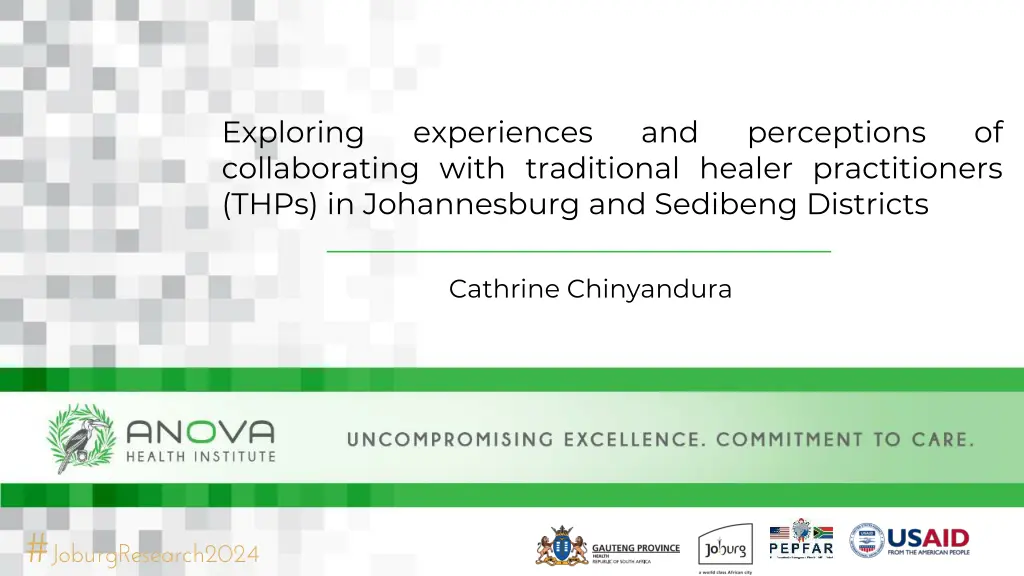
Exploring Collaborative Practices with Traditional Healers in Joburg
Learn about the experiences and perceptions of collaborating with traditional healer practitioners in Johannesburg and Sedibeng Districts through the lens of Cathrine Chinyandura's research. Discover the potential benefits, challenges, and opportunities for integrating traditional healers into healthcare systems and HIV programs.
Download Presentation

Please find below an Image/Link to download the presentation.
The content on the website is provided AS IS for your information and personal use only. It may not be sold, licensed, or shared on other websites without obtaining consent from the author. If you encounter any issues during the download, it is possible that the publisher has removed the file from their server.
You are allowed to download the files provided on this website for personal or commercial use, subject to the condition that they are used lawfully. All files are the property of their respective owners.
The content on the website is provided AS IS for your information and personal use only. It may not be sold, licensed, or shared on other websites without obtaining consent from the author.
E N D
Presentation Transcript
Exploring collaborating with traditional healer practitioners (THPs) in Johannesburg and Sedibeng Districts experiences and perceptions of Cathrine Chinyandura #JoburgResearch2024
Presentation outline Background Objectives Methodology Results Conclusions Recommendations #JoburgResearch2024
Background Multidisciplinary and intersectoral collaboration is an important strategy in the strengthening of health systems and implementation of HIV, TB, and STIs programs. Collaborating with THPs presents an opportunity to increase HIV testing, retention in care, and adherence to antiretroviral therapy (ART). In South Africa, studies have documented THPs role in managing HIV, TB, and STIs, and provision of maternal health services. WHO recommends the integration of THPs into national HIV programs and collaboration with biomedical care providers.
Study Objectives Explore perceptions of collaborating with traditional health practitioners (THPs). health workers' Identify opportunities collaboration. challenges for and effective #JoburgResearch2024
Methodology 1 We conducted in-depth interviews using a semi-structured interview guide Study design 5 CLOs 4 HTS Coordinators 1 Program Manager 2 Participants 3 Location The study was conducted in the Johannesburg & Sedibeng districts 4 Thematic analysis was used to analyze the data using the Nvivo software. Data analysis
Results It is possible to work with THPs as some of them have invited us to conduct HIV testing at their sites. Some really want to work with us . Collaboration is feasible One lady was excited at the collaboration it was not the first time I engaged her, we met her when we were piloting HIVSS and that lady a year or two years ago was interested . Willingness to collaborate Access individuals/groups who do not visit facilities to They are popular with amageza (taxi drivers) because there is no queue and they say they are respected . health It s not one-way traffic, as much as we can transfer skills and knowledge from them, we have a lot we can learn from them . Sharing of knowledge and skills
Results They are based in the community so we can ride on that and they know all the important stakeholders in the community . Community presence THPs, these guys touch on everything they provide physical, mental, spiritual, and even deal with issues like GBV, which is what patients need. Holistic care They meet the patient at his level, and they tailor their treatment plans to patient preferences and needs . Patient-centred care You know THPs deal with a lot of matters. This can allow us to explore other areas of collaboration Explore new areas of collaboration
Potential barriers to the collaboration differing divergent perspectives on the causes and treatment of diseases potential regulatory barriers. institutional - bureaucracy in umbrella bodies cultural barriers- varying values, and different capacities philosophies of care - Addressing these challenges is crucial for creating a collaborative environment.
Conclusions Collaborating with THPs is feasible and has the potential to improve patient care and widen access to care. As respected, culturally accepted, and trusted community gatekeepers, indispensable resource that can act as a bridge between communities and health facilities. THPs are an Building addressing cultural barriers. effective institutional, collaboration administrative, requires and #JoburgResearch2024
Recommendations Revive and strengthen health facility committees. Create bi-directional referral pathways between THPs and health facilities. Provide evidence-based feedback to the THP sector in SANAC. #JoburgResearch2024






















